HDR portraits pop on mobile devices by combining multiple exposures to enhance detail in bright and dark areas. You'll capture stunning depth and balanced lighting, even in challenging conditions. Use soft, diffused light to minimize harsh shadows and enhance skin tones. Compose your shots with the rule of thirds or leading lines for visual impact. Experiment with HDR-specific camera apps for manual controls and real-time previews. Balance shadows and highlights carefully to reveal hidden details without overprocessing. Pay attention to natural-looking skin tones and subtle enhancements. With the right techniques and accessories, you can elevate your mobile HDR portraits to professional levels.
Understanding HDR in Mobile Photography
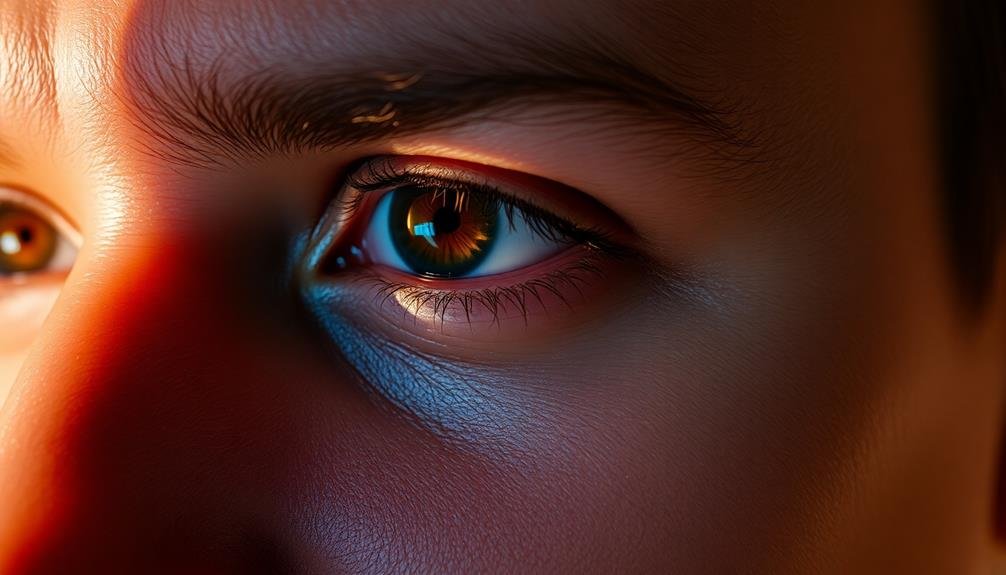
Nearly every modern smartphone comes equipped with HDR capabilities, revolutionizing mobile photography. HDR, or High Dynamic Range, is a technique that combines multiple exposures of the same scene to create a single image with improved detail in both bright and dark areas.
When you take an HDR portrait on your mobile device, it captures several shots at different exposure levels in rapid succession. The phone's software then merges these images, selecting the best-exposed parts from each to create a final photo with enhanced dynamic range.
This process allows you to capture portraits with more balanced lighting, bringing out details in shadows without overexposing highlights. You'll notice improved clarity in your subject's facial features, clothing textures, and background elements.
HDR is particularly useful in challenging lighting situations, such as backlit portraits or scenes with high contrast. It helps you avoid blown-out skies or overly dark shadows that often plague standard mobile photos.
To get the most out of HDR portraits, keep your hand steady and choose scenes with a mix of light and dark elements. Experiment with your phone's HDR settings to find the right balance for your style.
Lighting Techniques for HDR Portraits
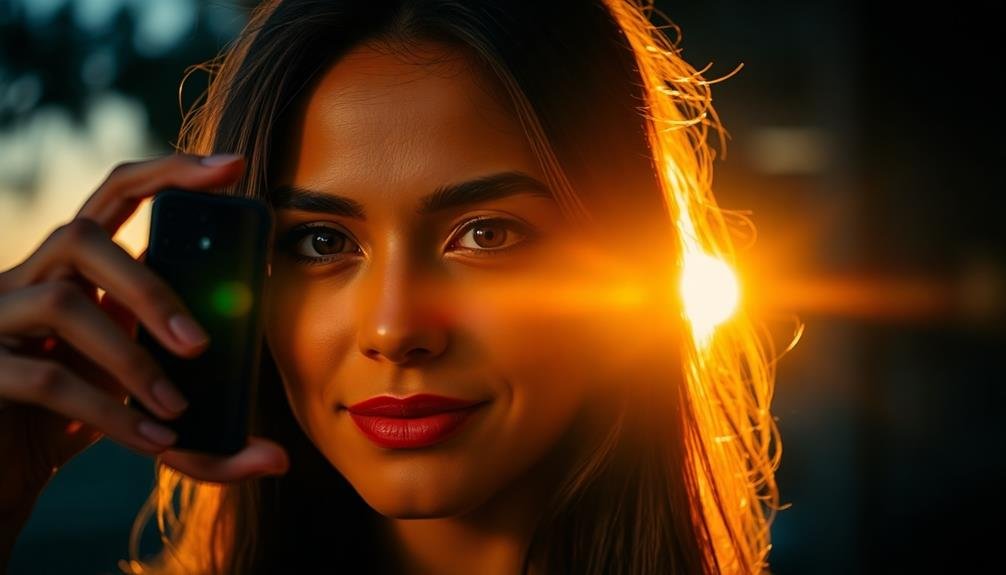
When capturing HDR portraits on your mobile device, you'll need to decide between natural and artificial light sources.
Natural light can provide a soft, flattering look, but it's not always available or consistent.
Regardless of your light source, aim for soft lighting to minimize harsh shadows and create a more balanced HDR portrait.
Natural vs. Artificial Light
Both natural and artificial light sources play essential roles in creating stunning HDR portraits on mobile devices. When shooting outdoors, you'll find that natural light offers a soft, flattering glow that enhances skin tones and creates depth.
Golden hour, just after sunrise or before sunset, provides warm, directional light that's ideal for HDR portraits. Overcast days can also work well, offering diffused light that minimizes harsh shadows.
Artificial light, on the other hand, gives you more control over your lighting setup. You can use LED panels, ring lights, or even household lamps to achieve the desired effect.
These sources allow you to manipulate shadows, highlights, and color temperature to your liking. When using artificial light, experiment with different angles and intensities to create dramatic contrasts that HDR can capture effectively.
For the best results, consider combining natural and artificial light. Use natural light as your main source and supplement with artificial light to fill in shadows or add a catchlight to the eyes.
This hybrid approach can result in portraits with depth, dimension, and a professional look, even when shot on a mobile device.
Soft Light Importance
Soft light is the cornerstone of flattering HDR portraits on mobile devices. It's essential for creating smooth, even skin tones and minimizing harsh shadows that can detract from your subject's features.
When you're shooting HDR portraits, prioritize soft light to achieve a more natural and appealing look.
To create soft light, you'll want to diffuse your light source. If you're working with natural light, try positioning your subject near a large window with sheer curtains. This will scatter the light, creating a gentle, wrapping effect.
For artificial lighting, use softboxes, umbrellas, or bounce the light off a white wall or ceiling.
Soft light is particularly vital in HDR photography because it helps maintain detail in both highlights and shadows. It reduces the overall contrast in your scene, making it easier for your mobile device to capture a wider dynamic range.
This results in portraits with balanced exposures and rich, nuanced tones.
Composition Rules for Striking HDR

Mastering composition is essential for creating stunning HDR portraits on mobile devices. You'll need to understand key principles to make your photos truly pop. Start by applying the rule of thirds, dividing your frame into a 3×3 grid and placing your subject along the lines or at intersections. This creates a more balanced and visually appealing image.
Consider these additional composition rules for striking HDR portraits:
| Rule | Description |
|---|---|
| Leading Lines | Use natural lines to guide the viewer's eye |
| Symmetry | Create balance with mirror-like compositions |
| Framing | Use elements to frame your subject |
| Negative Space | Incorporate empty areas for visual impact |
Don't forget to experiment with different angles and perspectives. Try shooting from low or high vantage points to add interest. Pay attention to the background, ensuring it complements your subject without overpowering it. Use foreground elements to add depth and dimension to your HDR portraits. Remember, HDR can enhance details and textures, so choose backgrounds that will benefit from this effect. By combining these composition techniques with HDR technology, you'll create enchanting portraits that stand out on mobile devices.
Best Camera Apps for HDR
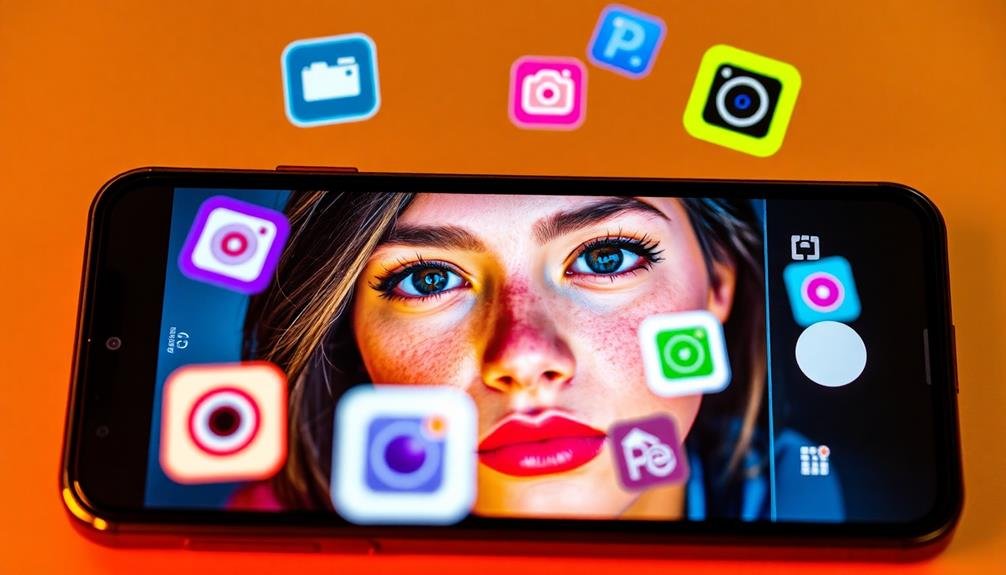
You'll find numerous camera apps capable of capturing stunning HDR portraits on your mobile device.
When choosing the best app for your needs, consider features like manual exposure controls, real-time HDR preview, and RAW capture support.
Compare the editing capabilities of different apps to guarantee you can fine-tune your HDR portraits with precision, adjusting highlights, shadows, and color balance to achieve the perfect look.
Top HDR Camera Apps
While many smartphones now come with built-in HDR capabilities, dedicated HDR camera apps can take your portrait photography to the next level.
These apps offer advanced features and greater control over your HDR shots, allowing you to capture stunning portraits with enhanced dynamic range and detail.
Here are four top HDR camera apps to evaluate:
- ProCamera: This versatile app offers manual controls, real-time HDR preview, and advanced editing tools. It's perfect for both beginners and seasoned photographers.
- Adobe Lightroom Mobile: Known for its powerful editing capabilities, Lightroom also includes an HDR capture mode that produces impressive results, especially in high-contrast scenes.
- Camera+ 2: With its intuitive interface and robust HDR mode, Camera+ 2 excels at capturing portraits with balanced exposure and rich details.
- Focos: This app combines HDR technology with depth-of-field effects, allowing you to create professional-looking portraits with beautifully blurred backgrounds.
When choosing an HDR camera app, evaluate factors such as ease of use, manual control options, and post-processing features.
Experiment with different apps to find the one that best suits your style and needs, and don't be afraid to push the boundaries of your mobile portrait photography.
Features to Look for
When selecting the best HDR camera app for your mobile device, it's important to understand the key features that can elevate your portrait photography.
Look for apps that offer manual exposure controls, allowing you to adjust shutter speed, ISO, and aperture. This gives you more control over the final image and helps you capture the perfect HDR portrait.
Ensure the app provides real-time HDR preview, so you can see how the final image will look before taking the shot. This feature helps you compose your portrait more effectively.
Multi-frame capture is another vital feature, as it allows the app to take multiple exposures and combine them for a more balanced result.
Seek apps with advanced tone mapping algorithms, which help to bring out details in both highlights and shadows.
Auto-alignment and ghost removal features are essential for reducing motion artifacts in your HDR portraits.
Additionally, look for apps that offer selective adjustments, allowing you to fine-tune specific areas of your image.
Editing Capabilities Comparison
Top-tier HDR camera apps offer a range of editing capabilities that can transform your mobile portraits. When comparing editing features, you'll find that some apps excel in specific areas while others provide a more extensive toolkit.
Adobe Lightroom Mobile stands out with its advanced color grading and tone curve adjustments, allowing you to fine-tune your HDR portraits with precision.
Snapseed, on the other hand, offers a user-friendly interface with powerful selective editing tools, perfect for enhancing specific areas of your image.
VSCO is known for its film-like presets and subtle adjustments, ideal for achieving a more artistic look in your HDR portraits.
ProCamera takes a different approach, focusing on raw editing capabilities and manual controls for those who prefer a more hands-on editing experience.
When choosing an app for editing HDR portraits, consider these key factors:
- RAW support for maximum editing flexibility
- Advanced color grading tools for fine-tuning skin tones
- Selective editing capabilities for targeted adjustments
- HDR-specific features like highlight recovery and shadow boosting
HDR Mode vs. Manual Shooting
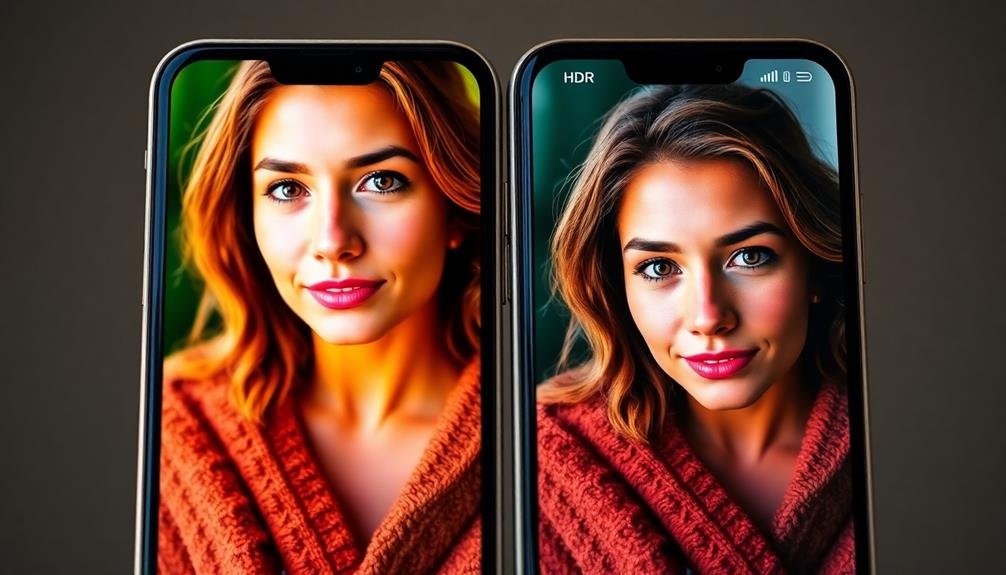
The battle between HDR mode and manual shooting rages on in the world of mobile photography. When it comes to HDR portraits, you'll need to decide which approach suits your style and subject best.
HDR mode automatically captures multiple exposures and blends them, ideal for high-contrast scenes. It's quick, convenient, and often produces balanced results without much effort.
Manual shooting, on the other hand, gives you complete control over exposure, white balance, and focus. You'll need to adjust settings yourself, but this allows for more creative freedom and precision. It's particularly useful when HDR's automated process struggles with moving subjects or complex lighting.
Consider your subject and environment when choosing between HDR and manual. HDR excels in scenes with stark contrasts, like backlit portraits or landscapes with bright skies.
Manual shooting shines in low light or when you want to emphasize specific elements of your composition. Experiment with both methods to understand their strengths and limitations.
Ultimately, mastering both HDR and manual techniques will expand your creative toolkit, enabling you to capture stunning portraits in any situation.
Editing HDR Portraits on Mobile
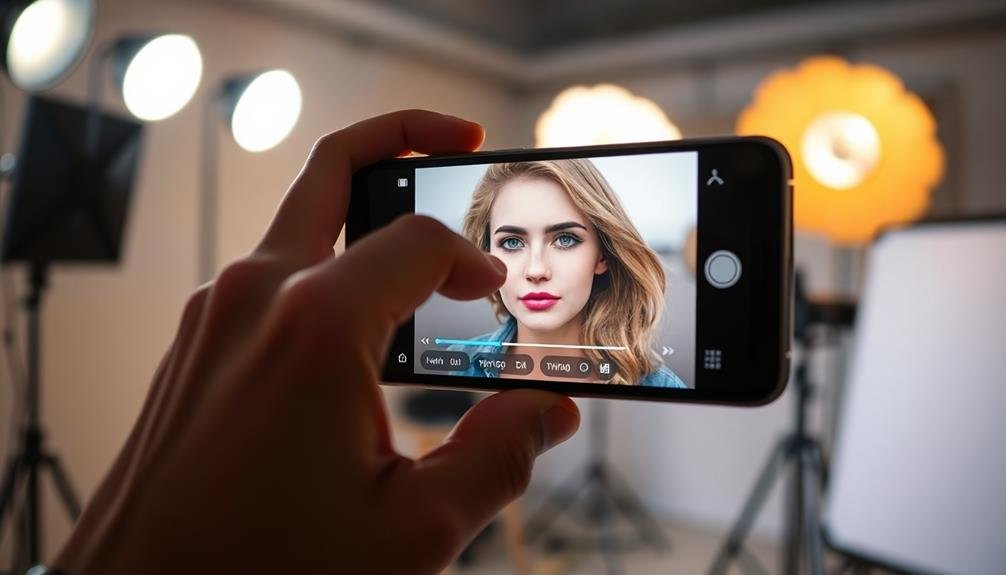
Frequently, capturing the perfect HDR portrait is just the beginning of your creative process. Once you've taken your shot, it's time to enhance and refine your image using mobile editing tools. Most smartphones now come with built-in editing features that allow you to fine-tune your HDR portraits right on your device.
When editing HDR portraits on mobile, focus on these key areas:
- Exposure and contrast: Adjust these to balance the highlights and shadows, ensuring your subject stands out without losing detail in bright or dark areas.
- Color temperature: Tweak the warmth or coolness of your image to achieve the desired mood and skin tone accuracy.
- Sharpness and clarity: Enhance facial features and textures without overdoing it, maintaining a natural look.
- Local adjustments: Use selective editing tools to brighten eyes, smooth skin, or emphasize specific areas of the portrait.
Don't be afraid to experiment with different editing styles and presets available in mobile apps.
Capturing Skin Tones With HDR
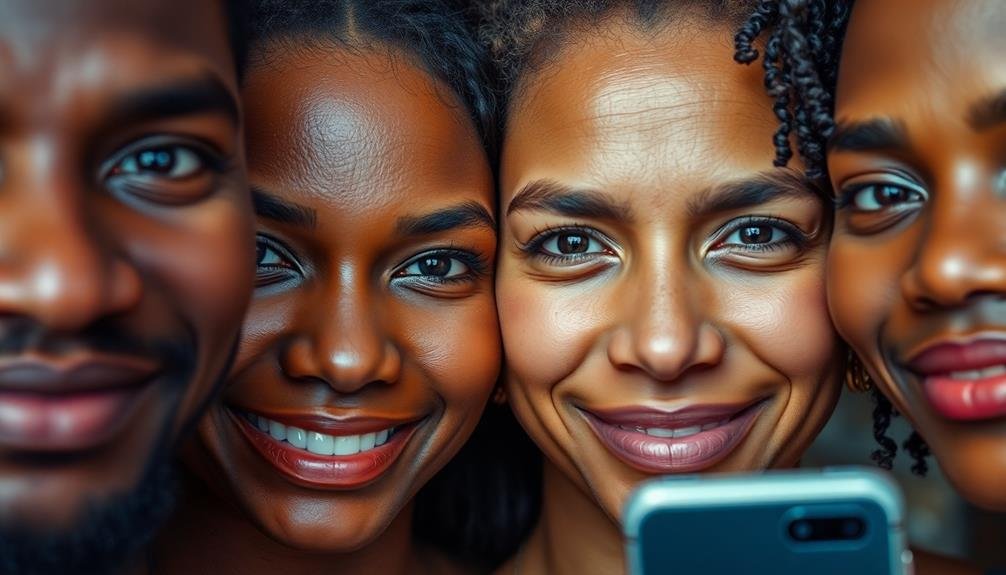
Capturing accurate skin tones is one of the most challenging aspects of HDR portrait photography on mobile devices. HDR technology can help you overcome this challenge by balancing exposure and preserving details in both highlights and shadows.
To get the best results, start by ensuring your subject is well-lit with soft, diffused light. This will minimize harsh shadows and help maintain even skin tones.
When shooting, use your device's HDR mode or a third-party HDR app. These tools will capture multiple exposures and blend them to create a balanced image. Pay attention to the background and foreground elements, as they can affect how your camera interprets skin tones. You'll want to avoid extreme contrast between your subject and their surroundings.
After capturing the image, fine-tune the skin tones in post-processing. Many mobile editing apps offer specific tools for adjusting skin tones. Look for options to tweak warmth, tint, and saturation.
Be careful not to overdo it – aim for natural-looking results that enhance your subject's unique features. Remember, HDR should enhance reality, not create an artificial look.
Balancing Shadows and Highlights
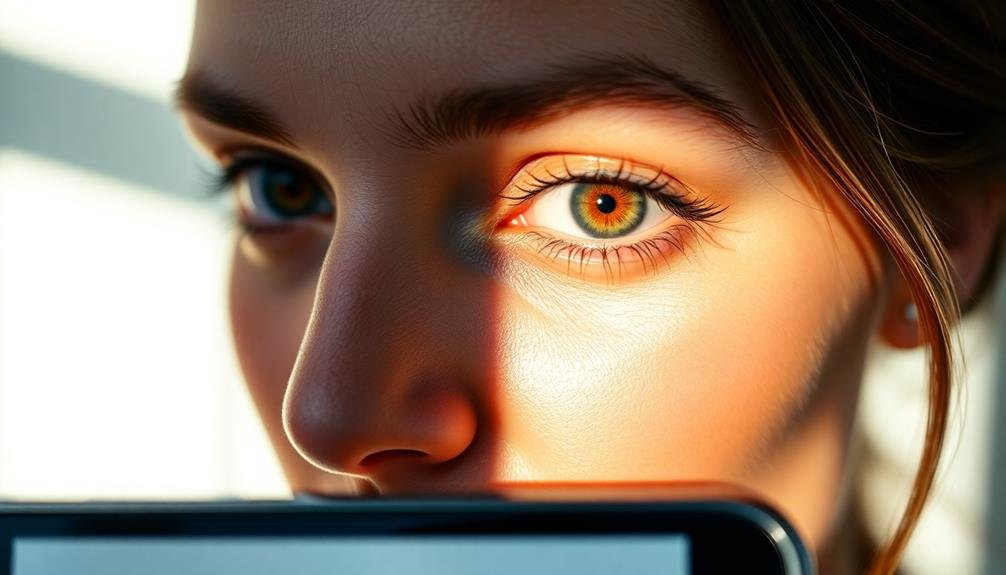
When capturing HDR portraits on your mobile device, you'll want to balance shadows and highlights effectively.
By doing so, you can reveal hidden details in both dark and bright areas of the image while maintaining a natural appearance.
Adjust your camera's HDR settings to guarantee you're not over-processing the image, which can lead to an artificial look that detracts from the portrait's authenticity.
Revealing Hidden Details
Once you've mastered the basics of HDR photography, it's time to plunge into the art of revealing hidden details. This technique allows you to uncover subtle textures, intricate patterns, and delicate features that might otherwise be lost in shadows or blown-out highlights.
By carefully adjusting exposure levels and blending multiple images, you'll bring out the richness and depth in your portraits that viewers might miss with a single exposure.
To reveal hidden details effectively in your HDR portraits:
- Focus on areas with high contrast, such as hair textures, skin pores, or clothing fabrics.
- Use selective adjustments to enhance specific regions without affecting the entire image.
- Experiment with different HDR presets to find the perfect balance between natural and dramatic looks.
- Pay attention to edges and shifts to avoid halos or artificial-looking borders.
Maintaining Natural Appearance
Despite the power of HDR techniques, maintaining a natural appearance in your portraits is essential for creating compelling images. When balancing shadows and highlights, aim for a realistic representation of the subject rather than an overly processed look.
Start by adjusting the exposure settings to capture details in both bright and dark areas without washing out or darkening the image excessively. Pay close attention to skin tones, ensuring they remain true to life. Avoid pushing the HDR effect too far, as this can result in an artificial, plastic-like appearance.
Instead, use HDR to subtly enhance the dynamic range, bringing out details in the shadows and highlights without compromising the overall natural look. To maintain a realistic appearance, focus on preserving the contrast between light and dark areas.
Don't eliminate all shadows, as they contribute to the depth and dimensionality of the portrait. Use selective adjustments to fine-tune specific areas of the image, such as brightening the eyes or adding definition to facial features, while keeping the overall tonal balance intact.
HDR for Different Portrait Styles

HDR techniques can enhance various portrait styles, each with its unique requirements. When you're shooting different types of portraits, you'll need to adjust your HDR approach accordingly.
For formal portraits, use HDR to bring out subtle details in clothing and facial features while maintaining a polished look. In environmental portraits, HDR can help balance the subject with their surroundings, guaranteeing neither gets lost in the shadows or highlights.
For creative or artistic portraits, HDR opens up a world of possibilities. You can push the boundaries of contrast and color to create dramatic, eye-catching images.
When shooting candid portraits, HDR helps capture fleeting moments in challenging lighting conditions, preserving both highlight and shadow details.
To make the most of HDR in different portrait styles:
- Adjust the HDR strength based on the desired mood and atmosphere
- Pay attention to skin tones and confirm they remain natural-looking
- Use HDR selectively on specific areas of the image for more control
- Experiment with different HDR presets or settings to find what works best for each style
Common HDR Portrait Mistakes

While HDR can greatly enhance portrait photography, it's easy to make mistakes that detract from your images. One common error is overprocessing, which results in unnatural-looking skin tones and exaggerated textures. To avoid this, use HDR subtly and aim for a balanced, realistic look.
Another mistake is poor subject positioning. Make sure your subject isn't backlit or in harsh shadows, as HDR may struggle to compensate for extreme lighting conditions. Instead, place your subject in soft, diffused light for best results.
Lastly, neglecting to stabilize your device can lead to blurry or misaligned HDR shots. Use a tripod or steady your hands to capture crisp, well-aligned images.
| Mistake | Consequence | Solution |
|---|---|---|
| Overprocessing | Unnatural look | Use HDR subtly |
| Poor positioning | Harsh shadows | Seek diffused light |
| Camera shake | Blurry images | Use tripod or stabilize |
| Ignoring background | Distracting elements | Choose clean backgrounds |
Posing Subjects for HDR Portraits
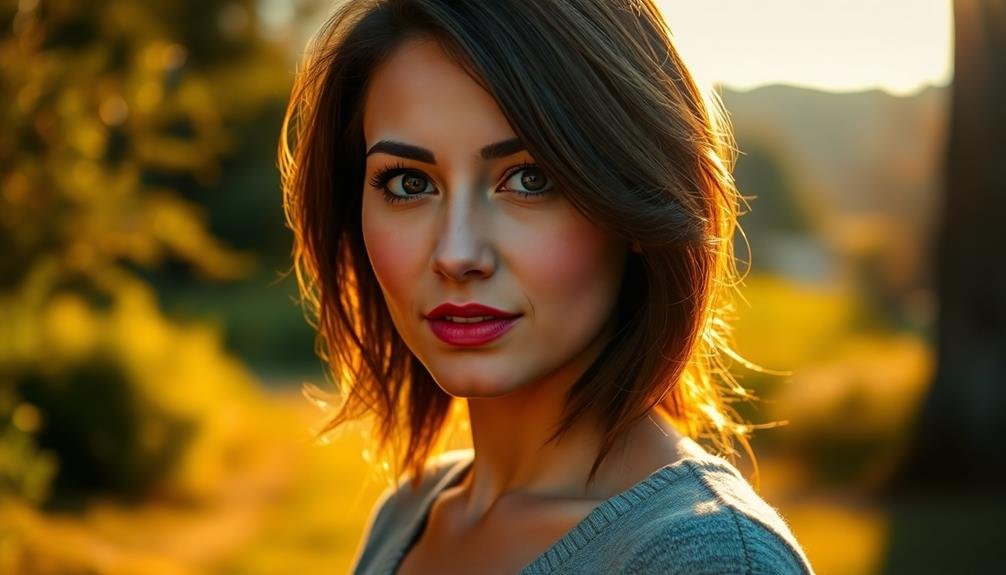
When capturing HDR portraits on your mobile device, you'll want to focus on emphasizing your subject's facial expressions.
Encourage your model to convey genuine emotions, as HDR can beautifully highlight subtle details in their features.
Additionally, don't be afraid to experiment with dynamic poses that create interesting shadows and highlights, allowing the HDR technology to truly showcase the depth and dimensionality of your portrait.
Emphasize Facial Expressions
Facial expressions are the heart and soul of any compelling portrait. When shooting HDR portraits on your mobile device, it's essential to emphasize and capture authentic emotions. Encourage your subject to relax and show genuine feelings, as these will translate beautifully in the final image.
Don't be afraid to experiment with different expressions, from subtle smiles to more dramatic looks.
To bring out the best facial expressions in your HDR portraits:
- Establish a rapport with your subject to help them feel comfortable and natural.
- Use prompts or ask questions to evoke genuine emotions.
- Capture a series of shots to catch fleeting expressions.
- Pay attention to the eyes, as they're often the focal point of a portrait.
Remember that HDR technology can enhance the details in facial features, so be mindful of how different expressions interact with lighting and shadows.
Soft, diffused light can help minimize harsh contrasts and create a flattering effect on the skin. By focusing on authentic facial expressions, you'll create HDR portraits that truly pop on mobile devices, capturing the essence of your subject's personality and emotions.
Utilize Dynamic Poses
Beyond facial expressions, dynamic poses can elevate your HDR portraits on mobile devices to the next level. When capturing HDR portraits, encourage your subjects to move and experiment with different positions. Ask them to tilt their head, angle their shoulders, or shift their weight from one foot to the other. These subtle adjustments can create more interesting compositions and add depth to your images.
Don't be afraid to have your subjects interact with their surroundings. They can lean against walls, sit on steps, or reach out to touch nearby objects. This interaction adds context and creates a more engaging narrative within the portrait.
For full-body shots, try having your subject walk towards the camera or strike a confident stance. These dynamic poses can convey energy and personality.
Remember to adjust your camera angle to complement the pose. Shooting from slightly below can make your subject appear more powerful, while a higher angle can create a sense of vulnerability. Experiment with different perspectives to find the most flattering and impactful combination of pose and camera angle for your HDR portraits.
HDR in Various Lighting Conditions

Sunlight, shadows, and artificial illumination all present unique challenges for HDR portrait photography on mobile devices. You'll need to adapt your approach based on the lighting conditions to capture stunning HDR portraits.
In bright sunlight, HDR helps balance harsh contrasts between highlights and shadows, preserving detail in both areas. For shadowy environments, HDR can bring out hidden details and add depth to your subject's features.
When working with artificial lighting, HDR technology allows you to capture the nuances of different light sources, from warm incandescent bulbs to cool fluorescent lights.
To make the most of HDR in various lighting conditions, consider these tips:
- Use a tripod or steady surface to minimize camera shake
- Experiment with different exposure levels to find the ideal range
- Pay attention to the direction and quality of light sources
- Adjust your HDR settings based on the specific lighting scenario
Achieving Natural-Looking HDR Results

One of the biggest challenges in HDR portrait photography is achieving natural-looking results. To create portraits that don't look overprocessed, you'll need to strike a balance between enhancing details and maintaining a realistic appearance.
Start by carefully adjusting your exposure settings. Aim for a slightly underexposed base image to prevent blown-out highlights. When merging exposures, use a light touch with the HDR slider to avoid an artificial look. Pay attention to skin tones, making certain they remain natural and not overly smoothed or saturated.
Focus on enhancing the subject's features subtly. Bring out the eyes by slightly increasing their contrast and sharpness. Soften harsh shadows around the nose and under the chin, but don't eliminate them entirely, as they provide depth and dimension.
Be mindful of halos and artifacts that can appear around edges. Use selective adjustments to refine problematic areas without affecting the entire image.
HDR Portrait Accessories for Smartphones

Smartphone accessories can greatly enhance your HDR portrait photography. By investing in the right tools, you'll be able to capture stunning, professional-looking HDR portraits with your mobile device.
Here are four essential accessories to take into account:
- External LED light: A portable LED light panel provides additional illumination, helping you control shadows and highlights in your HDR portraits. It's especially useful in low-light situations or when you need to balance harsh sunlight.
- Clip-on lenses: Wide-angle, macro, or telephoto lenses expand your creative possibilities. They allow you to experiment with different focal lengths and perspectives, adding depth and interest to your HDR portraits.
- Tripod or stabilizer: Steady shots are vital for HDR photography. A compact tripod or smartphone stabilizer helps eliminate camera shake, ensuring sharp, well-aligned images for HDR processing.
- Remote shutter: This simple accessory lets you trigger your camera without touching the device, further reducing the risk of blur. It's particularly useful for self-portraits or when you need to maintain a specific composition.
With these accessories, you'll have greater control over your HDR portrait shots, resulting in more dynamic and visually appealing images straight from your smartphone.
Frequently Asked Questions
Can HDR Portraits Be Taken Underwater With Waterproof Smartphone Cases?
Yes, you can take HDR portraits underwater with waterproof smartphone cases. You'll need a case rated for your dive depth and good lighting. Be aware that water can affect color and clarity, so adjust your settings accordingly.
How Does HDR Affect Battery Life When Shooting Portraits on Mobile Devices?
HDR can drain your battery faster when shooting portraits on mobile devices. You'll notice increased power consumption as your phone processes multiple exposures. It's best to have a charger handy for extended HDR photo sessions.
Are There Cultural Considerations When Using HDR for Portraits in Different Countries?
You'll find cultural sensitivity matters when using HDR for portraits abroad. Consider local preferences for skin tones, lighting, and image aesthetics. What's flattering in one culture may not be in another, so adapt your approach accordingly.
Can HDR Portraits Be Effectively Printed, or Are They Best Viewed Digitally?
You can print HDR portraits effectively, but they're often best viewed digitally. Digital displays can show a wider range of colors and contrast. However, with high-quality printers, you'll still achieve stunning printed results.
How Does HDR Portrait Performance Vary Between Android and Ios Devices?
You'll find HDR portrait performance varies between Android and iOS devices. While both offer HDR capabilities, iOS tends to have more consistent results across devices. Android's performance can differ based on the manufacturer and model you're using.
In Summary
You've now got the tools to make your HDR portraits pop on mobile devices. Remember, it's all about balancing light, composition, and technique. Don't be afraid to experiment with different apps and lighting conditions. Practice posing your subjects and fine-tuning your settings. With time and patience, you'll master the art of HDR mobile photography, creating stunning portraits that captivate viewers and stand out on any screen. Keep shooting and refining your skills!





Leave a Reply